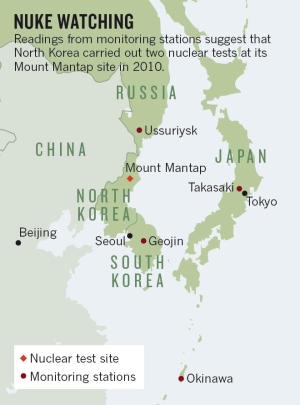The North Koreans allegedly conducted secret, nearly undetected nuclear tests in 2010. And they almost got away with it. That is, until Lars-Erik De Geer, an atmospheric scientist at the Swedish Defence Research Agency in Stockholm, took a closer look at the monitoring data from Russian and Japanese stations close to North Korea.
Reporting in Nature, Geoff Brunfiel explains that, in May of that year, detectors in South Korean picked up some radioactive xenon which became the topic of discussion three months later at a gathering at the CTBTO. At the time, no one could figure out where the xenon came from. However, De Geer decided to examine the data more closely and, nearly a year later, concluded that the North Koreans had conducted two clandestine nuclear tests – one in April and one in May of 2010.

The appearance of xenon-133 and xenon-133m, according to De Geer, point to the possible tests in mid-April. Barium-140 and decay product lanthanum-140 were detected in May, which De Geer believes indicate a second test. “In Sweden, we saw this kind of thing decades ago from Russian underground tests.” De Geer’s analysis will appear in the April/May issue of Science and Global Security.
But, not everyone is convinced of De Geer’s findings. Jeffrey Lewis, father of Arms Control Wonk and now director of the East Asia non-proliferation program at the Monterey Institute of International Studies in California and Ola Dahlman, a retired geophysicist who previously worked with the CTBTO, are skeptical that De Geer’s data conclusively point to nuke tests. Both believe that, absent additional data, including seismic data, it is not clear that the presence of xenon means that the tests did occur. Lewis, for example, points to the operation of a number of nuclear power plants in the vicinity of the sensors and which could have been responsible for the presence of xenon.
Nonetheless, the discussion surrounding the xenon detection and other data will no doubt serve to strengthen the network by encouraging analysis of abnormalities and other unexplained evidence picked up by the CTBTO’s sensors.